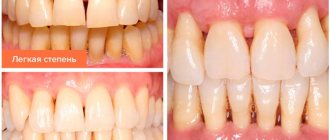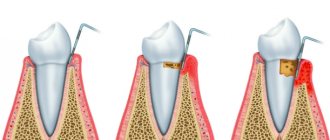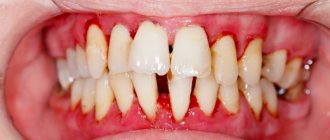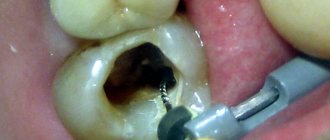All people have a unique appearance and unique facial features. Some of us sometimes experience gaps between our teeth. Sometimes this defect may be subtle. But in other cases, such imperfection leads to serious physical as well as psychological consequences, and the issue of correcting this disorder is very relevant for a person.
Classification of dental gaps
Diastemas
– these are gaps of any size between the front central incisors. Tremae are spaces between any other teeth in the upper or lower jaw. Gaps between the lower front incisors are uncommon, but gaps between the upper central teeth can be seen several times more often. In many cases, the presence of a diastema of this kind provokes serious psychological discomfort, interfering with the harmonious socialization of patients.
Depending on what type of teeth are – baby or permanent – a distinction is made between false and true gaps between them. False dental gaps are observed in children - such defects go away on their own along with the change of teeth. True gaps form between permanent teeth and can only be removed with specialized help from a dentist. Doctors advise starting to correct such defects immediately after they occur, since then it will require much less time and effort.
What is diastema
The dentition is not always continuous. Often they contain enlarged spaces - trema between the teeth (from the Greek trema - hole). Such chips can be from 1 to 10 millimeters in size. In dentistry, the space between the front teeth in the center of the upper dentition is designated by the separate term “diastema.” Moreover, diastema of the upper teeth is more common than the lower ones.
Experts divide diastemas into false and true. If a gap appears in a child as a result of early loss of baby teeth, this is a false diastema, which will disappear on its own over time. However, parents often ask doctors why the distance between children's teeth increases with age. Because the jaw grows and there is more space on it, and the size of the teeth increases slightly. As a result, the chips become more noticeable. In this regard, true diastemas, that is, gaps between teeth in adults, must be corrected by resorting to the qualified help of an orthodontist.
Gap between teeth: what should be done?
If you have a very small diastema, then a visit to the dental clinic can wait. However, even a small gap should be regularly monitored by a doctor, since tooth gaps tend to grow over time. However, if the diastema is significant, it is better to visit the dentist as soon as possible. This defect can contribute to the development of caries, malocclusion, gum disease, etc. Various methods have been developed for correcting diastemas. Typically, the doctor carries out treatment on an individual basis and selects a method that will be most effective for a particular patient. The technique is chosen based on the reasons for the appearance of a gap between the teeth, the size and degree of development of the dental gap, and the wishes of the person himself.
Use of artistic restoration
Some patients are advised to undergo aesthetic artistic dental restoration to eliminate diastema. This is a therapeutic intervention during which composite microprostheses (veneers) are installed on the two central incisors, between which there is a gap. The doctor uses a filling material that matches the patient’s natural enamel shade and builds up additional volume of hard tissue on the two central front teeth. To undergo this procedure, you only need to visit the clinic once.
When restoring a tooth, the doctor restores its shape and function. The presence of colored deposits and cracks in the enamel, and other signs of destruction of dental tissue does not play any role, since most of the visible dental tissue is removed. Then its natural shape, color and functional properties are formed using composite materials (build-up method). If the root of a tooth is damaged, it is treated first, and restoration is carried out only at the next stage. If no pathologies associated with the tooth root are detected, then in 5-6 hours a qualified doctor is able to restore at least 4-5 teeth. However, if the dentist first works with the root of the tooth, then further manipulations are carried out after at least two days.
An important advantage of artistic restoration is its complete painlessness. Another important advantage of this method is its safety, therefore it has a minimal list of contraindications. Dental restoration can be performed on women even during pregnancy.
Types of resorption
There are also two types of resorption, each of which, without treatment, can provoke complete tooth loss or partial tooth loss.
Internal resorption
Dentin (or cement shell) is absorbed into the root canal, dissolves, and disappears. Inflammation begins inside the tooth and then spreads to the outer surfaces. Usually the cause of the pathology is injury, burn (thermal, chemical), infection. Inflamed cells increase in size. The structure of soft and hard tissues changes. Symptoms of resorption:
- Changing the shade of the dental unit to pink. The tissue of the neurovascular bundle turns into granulomatous. After dying it turns gray.
- Painful sensations appear.
- The mobility of the units is noticeable.
Without diagnosis, the tooth becomes an empty shell. It is susceptible to caries, fragile - it splits at the slightest load. In the early stages, it is detected during preventive examinations or as a concomitant option in the treatment of other teeth.
External resorption
The reason is a consequence of injury, infection or a rapid change in the position of the roots (possible when installing braces). The enamel also changes color to medium red or pink. Develops at the junction with the tissues of the jaw. Causes:
- The action of pathogenic microflora inside the root canal.
- Dislocation of teeth.
- Necrosis of the nerve bundle.
There are no obvious symptoms. Blood capillaries of the gums and surrounding tissues penetrate into the tooth root, changing the shade of the crown. Changes can be detected by taking an x-ray. Rarely diagnosed in the early stages, loss of chewing teeth or loss of central teeth is possible. Doctors note an aggressive course, rapid development with extensive destructive processes, resorption of the dental bone tissue begins.
Surgical plastic surgery
For many patients, the determining factor in choosing a method for eliminating diastema is the cost of therapy. Be sure to consider your financial resources when you and your doctor select a method for correcting a dental gap. Choose the method that suits you best, but do not skimp on your health, as otherwise you may not achieve what you want and spend even more money on eliminating the negative consequences of unsuccessful treatment.
A tooth gap can also be removed using surgical plastic surgery. This technique involves installing dental crowns. Dentists correct the defect by placing ceramic veneers or crowns on the front teeth. This intervention allows you to achieve an excellent aesthetic effect that lasts for many years. Some disadvantage of this technique is its rather high price.
If for one reason or another you cannot use this technique, the doctor can fill the front teeth for corrective purposes, as a result of which the gap will be eliminated. Pay attention to the above method if the diastema occurs a second time or the installation of staples does not bring the desired result.
Orthodontic correction methods
Orthodontic methods for correcting diastemas are rightfully considered the safest, most effective and gentle (they allow you to preserve a maximum of healthy dental tissues). However, their main drawback is the long duration of treatment. Malocclusions are eliminated step by step - for this, braces are used. Orthopedic treatment is primarily indicated for children and adolescents whose permanent teeth have recently replaced their deciduous predecessors. Braces are special orthodontic structures that are attached to the teeth from the inside (invisibility braces) or the outside. How long do you need to wear braces? This is determined by the doctor individually, but usually treatment continues until the bite is completely corrected (from 6 to 24 months). It is best to install braces when the jaw is actively growing.
Your dentist may also recommend mouth guards, which are small transparent covers for your teeth. Aligners contain information about the normal shape and size of teeth. These devices are made in such a way that they move individual teeth in the required direction, restoring their correct position. The result of this is that the teeth move closer to each other and the diastema is eliminated. Aligners have a transparent base, so they are even less noticeable on the surface of the teeth than braces.
The advantage of mouth guards is that they can be removed while eating. Moreover, since they are filled inside with a whitening compound, using this method, you will not only eliminate the gap between the front incisors, but also lighten the tooth enamel. This will also add beauty to your smile and eliminate the need for additional whitening procedures.
Orthodontists are indispensable if a person, in addition to diastema, is diagnosed with any other malocclusion. Metal braces are considered affordable and reliable for most patients.
Diastema in celebrities
Teeth are the calling card of any famous person, and, according to many, they must be perfect. But there are many stars who have turned the gap between their teeth into their highlight. According to physiognomy, gaps between teeth are a sign of talent and creative potential.
Famous women with diastema
To the list of stars with diastema who became famous in the last century, in addition to Brigitte Bardot and Ornella Muti, you can add Lauren Hutton, who conquered the fashion industry back in the 60s of the 20th century. Among modern models is Georgia May Jagger, who became the face of the Chanel advertising company.
Diastema makes French celebrities even more attractive and is an integral part of their image. In addition to Vanessa Paradis with her pronounced diastema, one can remember the actress Jane Birkin, who considered the gap to be a “funny little thing.” Léa Seydoux, the performer of the role of Belle from Beauty and the Beast, is in no hurry to get rid of this defect.
American women are more conservative in this regard and strive for a Hollywood smile. Fifty Shades of Gray star Dakota Johnson once had a great sense of humor about her diastema. To be convinced of this, just watch a video of a famous American television show with her participation. But over time, the actress got rid of her diastema.
Famous men with diastema
Diastemas and trema in famous men are quite common. Among Hollywood veterans who got rid of the gap between their teeth, we note Arnold Schwarzenegger, Tom Cruise, Nicolas Cage. But the famous director Oliver Stone did not treat the diastema. The gap does not prevent Woody Harrelson, Eddie Murphy, and Laurence Fishburne from smiling widely.
Among the representatives of the younger generation who corrected diastema in their youth, we highlight Zac Efron and Matthew Lewis.
Johnny Depp and the cult director Tim Burton uniquely expressed their “love” for gap teeth by creating the image of the Mad Hatter in the film “Alice in Wonderland.”
You can have different attitudes towards diastema and trema, but you shouldn’t deny that they really suit some of the stars. Diastema can highlight a bright appearance and make it memorable.
All problems can be solved
An even dentition, white teeth of regular shape adorn any person and serve as an integral part of an ideal smile. Thanks to this, everyone can feel attractive, because in the modern world almost any dental defect can be successfully corrected. Thanks to this, many patients are able to return to normal life. Therefore, if you are concerned about the presence of a diastema, this imperfection can be corrected quite quickly and painlessly in dentistry near the Krasnye Vorota, Baumanskaya, Novokuznetskaya and Tretyakovskaya metro stations. Do not be indifferent to your health and psychological state, and confidently contact dental specialists to solve your problems.
Advantages of atraumatic tooth extraction
Compared to traditional methods, atraumatic tooth extraction has a number of advantages:
- The procedure does not cause any discomfort in the patient. Instead of ordinary forceps, dentists use special periotome knives, which allow them to cut the ligaments and carefully pull the root out.
- Thanks to the use of special preparations during atraumatic tooth extraction, bone tissue atrophy is prevented and the process of restoration and healing of the hole is accelerated. This is facilitated by the preservation of the interroot septum.
- Since bone tissue is not destroyed during atraumatic tooth extraction, the specialist has the opportunity to immediately perform one-step implantation.







